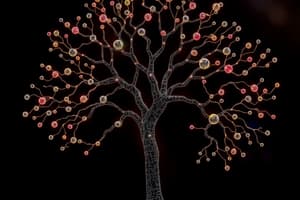Podcast
Questions and Answers
What defining characteristic distinguishes eukaryotes from prokaryotes?
What defining characteristic distinguishes eukaryotes from prokaryotes?
- Eukaryotes are always unicellular.
- Eukaryotes contain membrane-bound organelles. (correct)
- Eukaryotes lack a plasma membrane.
- Eukaryotes reproduce exclusively asexually.
What is the approximate size of typical eukaryotic cells?
What is the approximate size of typical eukaryotic cells?
- 1-5 mm
- 100-200 µm
- 1-10 µm
- 10-100 µm (correct)
What is meant by the term 'monophyletic group' regarding eukaryotes?
What is meant by the term 'monophyletic group' regarding eukaryotes?
- It contains the common ancestor and all of its descendants. (correct)
- It includes both prokaryotes and eukaryotes.
- It refers only to multicellular organisms.
- It includes only modern descendants without their common ancestor.
Which process is thought to be responsible for the evolution of the first eukaryotic cells?
Which process is thought to be responsible for the evolution of the first eukaryotic cells?
What do prokaryotes and eukaryotes differ in regarding cellular structures?
What do prokaryotes and eukaryotes differ in regarding cellular structures?
Which of the following is the correct first step in the origin of life on Earth?
Which of the following is the correct first step in the origin of life on Earth?
What is a protocell?
What is a protocell?
Which experiment simulated early earth's atmosphere to create organic compounds?
Which experiment simulated early earth's atmosphere to create organic compounds?
What role did catalysts such as clay play in the origin of life?
What role did catalysts such as clay play in the origin of life?
What hypothesis describes the early conditions that could lead to the emergence of life?
What hypothesis describes the early conditions that could lead to the emergence of life?
What is the first necessary step in the origin of life as described in the process of life formation?
What is the first necessary step in the origin of life as described in the process of life formation?
Which of the following substances was NOT synthesized during Stanley Miller's experiment?
Which of the following substances was NOT synthesized during Stanley Miller's experiment?
What distinguishes protocells from living organisms?
What distinguishes protocells from living organisms?
What role did deep-sea vents play in the context of the origin of life?
What role did deep-sea vents play in the context of the origin of life?
Which of the following conditions was NOT a part of the primordial soup hypothesis?
Which of the following conditions was NOT a part of the primordial soup hypothesis?
What process describes the decay of the isotope 14C into 14N?
What process describes the decay of the isotope 14C into 14N?
What is the half-life of Carbon-14?
What is the half-life of Carbon-14?
What factor contributes to the discontinuity in the fossil record?
What factor contributes to the discontinuity in the fossil record?
Which of the following ranges does Carbon-14 dating cover?
Which of the following ranges does Carbon-14 dating cover?
Which of the following does NOT contribute to the bias in the fossil record?
Which of the following does NOT contribute to the bias in the fossil record?
Flashcards
Eukaryotes
Eukaryotes
Organisms whose cells contain a nucleus and other membrane-bound organelles.
Monophyletic group
Monophyletic group
A group of organisms that includes the common ancestor and all its descendants.
Endosymbiosis
Endosymbiosis
The theory that some organelles within eukaryotic cells were once free-living prokaryotes.
Prokaryotes vs. Eukaryotes
Prokaryotes vs. Eukaryotes
Signup and view all the flashcards
Eukaryote size
Eukaryote size
Signup and view all the flashcards
Abiotic synthesis of organic molecules
Abiotic synthesis of organic molecules
Signup and view all the flashcards
Polymerization
Polymerization
Signup and view all the flashcards
Protocells
Protocells
Signup and view all the flashcards
Miller-Urey experiment
Miller-Urey experiment
Signup and view all the flashcards
Prebiotic soup
Prebiotic soup
Signup and view all the flashcards
Abiotic synthesis
Abiotic synthesis
Signup and view all the flashcards
Protocell
Protocell
Signup and view all the flashcards
Miller-Urey experiment
Miller-Urey experiment
Signup and view all the flashcards
Polymerization
Polymerization
Signup and view all the flashcards
Prebiotic soup
Prebiotic soup
Signup and view all the flashcards
Carbon-14 dating
Carbon-14 dating
Signup and view all the flashcards
Fossil record bias
Fossil record bias
Signup and view all the flashcards
Half-life (radioactive decay)
Half-life (radioactive decay)
Signup and view all the flashcards
Fossil record gaps
Fossil record gaps
Signup and view all the flashcards
Dating range (14C)
Dating range (14C)
Signup and view all the flashcards
Study Notes
Topic 8: The Tree of Life
- Life on Earth uses carbon (C), oxygen (O), hydrogen (H), and nitrogen (N) in organic molecules. These elements are highly abundant on Earth and in the atmosphere. Carbohydrates, proteins, fatty acids, and nucleic acids are primarily composed of these elements.
- Human body composition contains 96.3% oxygen, carbon, hydrogen, and nitrogen.
- The age of the universe is 13.8 billion years
- The age of the Earth is 4.6 billion years
- The first direct evidence of life is 3.5 billion years ago.
- Fossils are preserved remnants or impressions of organisms.
- Stromatolites are layered rocks formed by photosynthetic prokaryotes.
- The seven properties of life include: cellular organization, reproduction, metabolism, heredity and evolution, growth and development, regulation and homeostasis, and response to stimuli
- Viruses are not considered organisms because they lack cellular organization, internal metabolism, and growth.
Learning Outcomes (Topic 8)
- Describe 7 properties of life using an organism as an example.
- Justify the importance of C, H, N, and O in organic molecules.
- Explain how specific properties of life emerged during the formation of protocells.
- List advantages of ribonucleic acid molecules for the emergence of life.
- Explain how the fossil record provides evidence for the evolution of organisms.
- Compare two methods used to date fossils
- Describe how the Burgess Shale contributed to the understanding of evolution of animals
- Define mass extinction and give an example.
- Define adaptive radiation and give an example.
- Analyze graphical data to infer changes to taxonomy.
- List characteristics of LUCA (Last Universal Common Ancestor)
- Name characteristics for the 3 domains.
- Give examples of organisms from each domain of life.
- Explain the evolution of eukaryotes from endosymbiosis.
- Explain the evolution of multicellularity.
First Evidence of Life on Earth
- Age of the Universe: 13.8 billion years
- Age of Earth: 4.6 billion years
- First direct evidence of life: 3.5 billion years
- Fossilised Stromatolite: The earliest forms of life.
- Stromatolites are layered rocks.
From Organic Molecules to Protocells
- Four necessary steps for the evolution of life from abiotic molecules to protocells:
- Abiotic synthesis of small organic molecules (monomers)
- Polymerization of monomers into macromolecules
- Packaging of molecules into protocells
- Origin of inheritance through the transmission of self-replicating molecules
Stanley Miller's Experiment (1953)
- Created early Earth conditions (methane, ammonia, hydrogen) and lightning to synthesise organic molecules.
- Found amino acids and other organic molecules.
Formation of Macromolecules
- Polymers of amino acids and other nitrogenous bases can form spontaneously without enzymes or ribosomes.
- Precursor molecules, thermal energy (heat), and catalysts (Fe²⁺, Pb²⁺, Mg²⁺, etc.) are important components in the process.
- Clay is a mineral catalyst for polymerization of RNA.
Formation of Protocells
- Protocells are membrane-bound droplets that maintain an internal chemistry distinct from the external environment.
- Experiments have shown their spontaneous division, internal metabolism, and selective permeabilities
- Protocells are not living organisms.
- Properties of life can emerge from abiotic conditions.
Studying That Suits You
Use AI to generate personalized quizzes and flashcards to suit your learning preferences.




